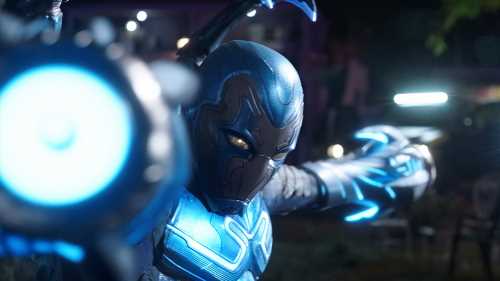
Is comic-book movie culture reaching a tipping point…into peak exhaustion? This summer, we’ve seen signs of that in the ho-hum box-office returns for “The Flash” and “Ant-Man and the Wasp: Quantumania.” To be fair, the mega-success of “Guardians of the Galaxy Vol. 3” and “Spider-Man: Across the Spider-Verse” has testified to the genre’s continuing appeal. Still, there are onscreen indicators that the superhero-movie audience, while it remains vast, might be entering the thrill-is-gone zone. As more and more of these films become cogs in a multiverse, their imaginative appeal tends to get trampled by the dictates of corporate world-building. (That “Ant-Man” sequel was designed to set up a saga of villainy longer than the Ring cycle.) Beyond that, it’s hard to escape the sensation that superhero films have become top-heavy with self-importance. The fate of the cosmos seems to ride on almost every one of them.
In that light, the brisk, cheeky, unabashed gizmo-happy triviality of “Blue Beetle,” a superhero origin story from the DC side of the tracks, is enough to make the film feel like a breath of fresh pulp. Its story could hardly be simpler, or of less consequence. Jaime Reyes (Xolo Maridueña), a boyishly cute college graduate, returns to Palmera City, the slightly futuristic hometown of his Latino immigrant clan, only to learn that he has no prospects, and that his family is broke and about to lose its home. Out with his sister, Milagro (Belissa Escobedo), on a house-cleaning gig, Jaime makes an innocent flirtatious connection with Jenny Kord (Bruna Marquezine), the prodigal scion of Kord Industries, which is run by Jenny’s cutthroat aunt, Victoria (Susan Sarandon). She stole the company from Jenny’s father and wants to turn it into a fascist anti-crime weapons syndicate.
Victoria has in her possession a blue metallic scarab that looks like a gaudy piece of brooch jewelry but is, in fact, a super-weapon — or, more precisely, a device that can turn you into one. Jenny steals the scarab from Kord headquarters, slipping it into a fast-food container, which she hands off to Jaime, who has shown up for a lunch date with her. At home, surrounded by his family, Jaime opens the box, and the scarab proceeds to leap right inside him, fusing with his mind, body, and central nervous system. A pair of skeletal blue pincers burst out of his back; the rest of him is covered with metallic armor. Just like that, he can repel bullets and fly into space. But he’s also got a voice in his head, a droid assistant who will now share space with his identity. The only way he can rid himself of the scarab is to die. Did I mention that Victoria wants her scarab back?
“Blue Beetle” is adapted from a DC comic that premiered in 2006 (two earlier incarnations of the Blue Beetle character appeared in 1939 and 1964), and as conceived by director Ángel Manuel Soto and screenwriter Gareth Dunnet-Alcocer, the fundamental cheesiness of “Blue Beetle” as a movie relates to how flamboyantly derivative it is. Jaime’s dewy-eyed youthfulness, and the way he gets “infected” by the scarab, descend directly from “Spider-Man.” Victoria wants to use the scarab to launch a privatized police force, an idea lifted right out of “RoboCop.” And the way that Jaime transforms into an invincible man-machine, so that we scan the world through his computerized laser vision, makes him a fusion of Iron Man, RoboCop, and the Terminator. But “Blue Beetle” is like a dark ’80s fantasia with a shaggy-haired boy-band hero in the middle of it.
Xolo Maridueña acts with a puppyish ingenuousness, so that even when he’s tormented by having his body play host to a techno parasite, the stakes feel more YA gee-whiz than cosmic apocalyptic. But Maridueña, playing Hollywood’s first Latino superhero, proves an appealing star. And the novelty of casting a comic-book blockbuster with a mostly unknown crew of vibrant Latino actors finds its emotional grounding in Jaime’s family, who with their squabbling competitiveness, precarious real estate, and elderly Nana (Adriana Barraza) who’s tougher than any of them may remind you of the family in “Encanto,” only in this case rooted in a shiny metropolis out of “The Lego Movie.”
George Lopez plays the acerbic tech wiz Uncle Rudy like Han Solo crossed with Tommy Chong; he’s a scene-stealer and then some. “You’re a superhero, cabrone!” he tells Jaime, more or less summing up the film’s attitude. By the time the family is coming to Jaime’s rescue by piloting a spaceship shaped like a bug with fruit-fly eyes, and Nana grabs a sci-fi machine gun as if born to it, you know just how seriously to take “Blue Beetle” (not very). But there’s a relief that comes with the film’s slightly absurdist jocularity.
It’s become standard to see a Marvel movie get steamrolled, in its final act, by the VFX department. You could say that the same thing happens in “Blue Beetle,” but the effects here, all magnetic waves of electric-blue light, plus clomping robot men (notably Victoria’s souped-up henchman, who appears to turn her on the more his body parts get replaced by metal), provide an old-school rock ’em sock ’em satisfaction. It’s not that the visual flimflam is awesome, exactly. It’s that it’s tactile enough to conjure a sensation of pre-digital kinetic innocence. Jaime, as Blue Beetle, learns how to turn his limbs into his weapon of choice, but the stakes never feel overblown. Jaime is just saving himself, and his family. The multiverse can wait.
Read More About:
Source: Read Full Article